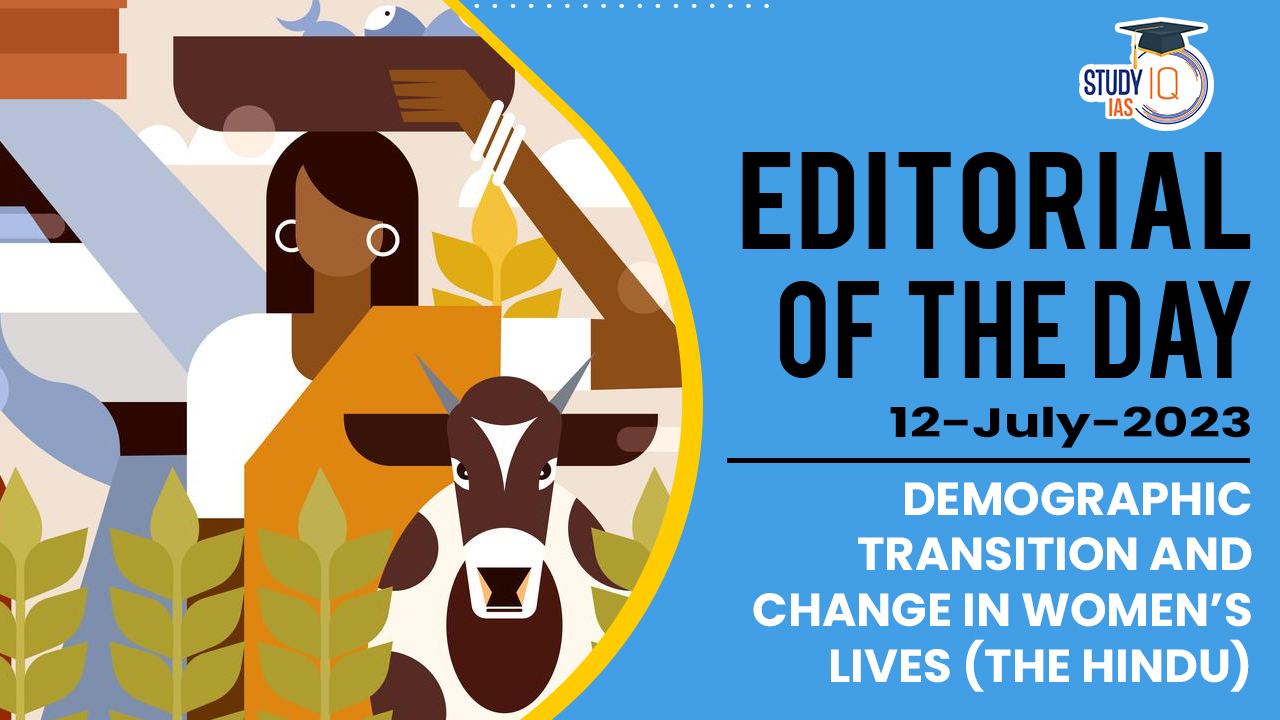Table of Contents
Context: The article is discussing the impact of India’s demographic journey on the lives of its citizens, particularly focusing on women. It highlights the significant growth in India’s population from around 340 million at the time of Independence to 1.4 billion, attributing this growth to factors such as improved public health, reduced starvation, and advancements in medical care. The article goes on to describe the changes in life expectancy over the years. It emphasizes the transformation brought about by increased life expectancy and decreased fertility rates, leading to adjustments in people’s lives, especially for women. It suggests that this demographic shift has affected women at different stages of life, including childhood, adulthood, and old age, with both positive and negative consequences.
Decoding the Editorial
The article talks about the demographic changes in India, including population growth, increased life expectancy, and declining fertility rates, have had a significant impact on the lives of its citizens, particularly women. The passage suggests that these changes have brought about a fundamental shift in the experiences of women at different stages of life—childhood, adulthood, and old age.
- The author mentions that there is a decline in mortality rates, due to improved public health and medical advancements, resulting in longer life expectancies for both men and women.
- This shift surprised parents who no longer needed to have as many children to ensure their survival.
- As a result, the population continued to grow until fertility rates also declined to align with the declining mortality rates.
- The Total Fertility Rate, which represents the average number of children born to a woman, fell from 5.7 in 1950 to 2.1 in 2019.
- The article suggests that these statistical changes mask the significant transformations that individuals have had to adapt to in the face of longer lifespans and smaller family sizes.
- These adjustments have had varying effects on the lives of Indian women, both positive and negative, across different stages of their lives.
Changes for Indian Women:
Indian women have experienced several changes over time that include:
- Son preference and sex-selective practices:
- As families started having fewer children, the preference for having at least one son became stronger.
- With smaller family sizes, the chances of not having a son increased, leading to sex-selective abortion and, in some cases, the neglect of sick daughters.
- This has resulted in a decline in the number of girls per 100 boys under the age of five.
- Shift in motherhood and caregiving:
- With a decline in fertility rates, women’s involvement in active mothering has decreased, allowing for more opportunities for education and employment.
- The number of years spent caring for children under five and children ages six to 15 has decreased over the years, creating space for other aspects of women’s lives.
- Education and early marriage:
- While women’s educational attainment has increased, early marriage and childbearing still play a significant role in shaping women’s lives.
- The average age at first birth has not significantly changed over the years, which can limit women’s opportunities for higher labour force participation and skilled jobs.
- Limited labour force participation:
- Early motherhood and the need to prioritise childcare often hinder women’s entry into the labour market.
- By the time women have fewer childcare responsibilities, they may have missed the window for occupations that require specific skills, leaving them with limited options for skilled work.
- Implications of ageing:
- With rising life expectancy, the proportion of the female population aged 65 and above has increased.
- Women are more likely to outlive their husbands, resulting in a higher proportion of widowed women who may face financial dependence on their children, particularly sons, due to limited access to savings and property.
- How should Gender Dividend be harnessed?
- Changing patriarchal norms: The article acknowledges that transforming deeply rooted patriarchal norms may require significant time and effort.
- Enhancing women’s access to employment and assets: By improving women’s access to employment opportunities and assets, their dependence on sons can be reduced. This, in turn, can break the cycle of gendered disadvantage that affects women throughout their lives, from childhood to old age.
- Differences in marriage and childbearing patterns: Unlike in East Asian countries where demographic changes have led to delayed or even forgone marriage and childbearing, early marriage and childbearing continue to be central aspects of Indian women’s lives which have to change.
- Importance of childcare: The article emphasizes the significance of accessible and affordable childcare in facilitating women’s participation in the labour force.
- It refers to a World Bank evaluation conducted in Madhya Pradesh, which found that expanding Anganwadis (childcare centers) to include a crèche resulted in increased work participation among mothers.
- It also cites a study from urban China that demonstrates how a decline in state support for childcare led to a decrease in employment rates for mothers.
- Practical strategies for enhancing childcare access:
- One suggestion is to consider making staffing crèches an acceptable form of work under the National Rural Employment Guarantee Scheme (NREGS), which is currently focused on physical infrastructure development.
- The burgeoning self-help group movement can also be leveraged to establish neighbourhood child-care centers in both urban and rural areas.
- Gender dividend and demographic dividend: Achieving the desired demographic dividend in India necessitates fully harnessing the gender dividend. Enhancing access to childcare is presented as a crucial element in this process.
Beyond the Editorial
Government Initiatives for Women Empowerment
- Beti Bachao Beti Padhao Scheme (2015): Objective: Prevent gender-biased sex selective elimination, ensure survival and protection of the girl child, and promote their education and participation.
- One-Stop Centre Scheme (2015): Objective: Provide support and assistance to women affected by violence, both in private and public spaces. Facilitate filing of First Information Reports (FIR/NCR) and offer psycho-social support and counseling.
Women Helpline Scheme (2016):
- Objective: Establish a toll-free 24-hour telecom service for women affected by violence. Provide crisis and non-crisis intervention through referral to appropriate agencies and offer information about support services and government schemes available to affected women.
UJJAWALA (2016):
- Objective: Prevent trafficking of women and children for commercial sexual exploitation. Rescue victims and provide them with immediate and long-term rehabilitation services, including shelter, food, medical treatment, counseling, legal aid, and vocational training.
Working Women Hostel (1972-73):
- Objective: Promote safe and convenient accommodation for working women. Provide accommodation for children of working women up to a certain age.
SWADHAR Greh (2018):
- Objective: Cater to the primary needs of women in distress by providing shelter, food, clothing, medical treatment, care, legal aid, and guidance.
Support to Training and Employment Programme for Women (STEP) (1986-87):
- Objective: Provide skill development programs to enhance employability of women aged 16 and above.
Nari Shakti Puraskar (2016):
- Objective: Recognize and strengthen the position of women in society. Acknowledge institutions working for women’s progress and development.
Mahila Shakti Kendras (MSK) (2017):
- Objective: Create an enabling environment for women by providing access to healthcare, quality education, guidance, employment opportunities, etc. at the block and district level.
NIRBHAYA (2012):
- Objective: Ensure safety and security for women by providing timely intervention, strict privacy, confidentiality, and addressing various forms of violence against women.
Mahila E-Haat (2016):
- Objective: Facilitate online entrepreneurship opportunities for women. Provide education and support for women to establish their ventures in online selling.
Mahila Police Volunteers (2016):
- Objective: Serve as a public-police interface to combat crimes against women. Report incidents of violence such as domestic violence, child marriage, dowry harassment, and violence in public spaces.


 Niveshak Didi Initiative Phase 2 launche...
Niveshak Didi Initiative Phase 2 launche...
 Central Pollution Control Board (CPCB) R...
Central Pollution Control Board (CPCB) R...
 Foreign Contribution Regulation Act (FCR...
Foreign Contribution Regulation Act (FCR...





















